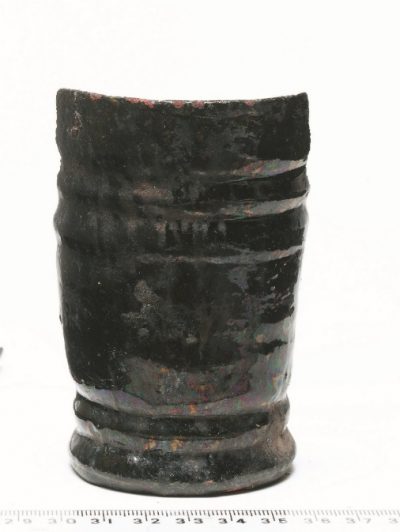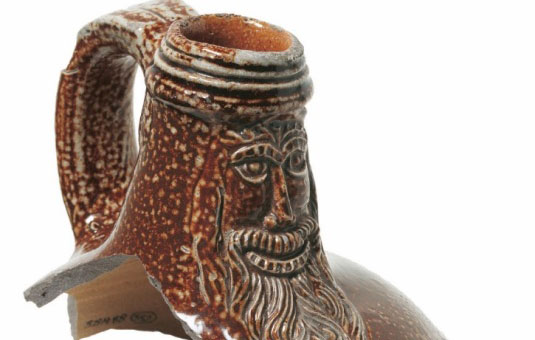There are a number of references to the consumption of food stuffs in the open playhouse in plays of the time: in Wit Without Money (1639 [1614]), John Fletcher has a character describe youths who ‘cracke nuts with Schollers in penny Roomes agen, and fight for Apples’;400 a ‘Puny Clerk,’ in Sir Thomas Overbury’s Characters (1615), ‘eates ginger bread at a play-house;’ 401 and in his prologue to the collection A Fancies Theatre (1640), John Tatham refers to the throwing of pears at the curtains by spectators to lure out the players at the open playhouses.402
Bowsher and Miller record that common foodstuffs found at the Rose site were:
- Cereals: wheat, rye, oats and barley, which may have been used for making bread, biscuits, cakes, pastries, and pottage. Wheaten bread was eaten by the better off; cheaper, coarser brown bread was eaten by the poor. (Wheat, barley and oats may also have been used for brewing.)
- Nuts: walnut, hazelnut, and almond.
- Fruit: pears and apples, are all present in the Rose remains; as well, grape, fig, blackberry/raspberry, elder, sloe/blackberry, cherry, and peach were also present (some of which may have been naturally growing near the playhouse; for example, the Sewers Commission mentions walnut trees growing on the south side of Maiden Lane). A large quantity of plum and cherry stones below the galleries suggest these were popular.
- Shell fish:Oysters seem to have been the most abundant shellfish, along with cockle and mussel.403
References to the consumption of drink at the playhouses refer to water or bottled ale. In a letter dated 2 July 1613, Sir Henry Wotton records his account of a fire at the first Globe in which ‘one man had his breeches set on fire, that would perhaps have broyled him, if he had not by the benefit of a provident wit, put it out with a bottle of ale.’404 In 1615, the writer John Stephens includes among the features of his character ‘a base Mercenary poet’ that ‘when he hears his play hissed, hee would rather thinke bottle Ale is opening.’405
Bowsher and Miller record: ‘Of the identifiable ceramic vessels from the Rose playhouse, 38% were drinking vessels. Of these, 16% were used for serving drink—for example, jugs, Bartmann jugs (fig. 112), flasks, and costrels. The remaining 22% were used for consumption and these included drinking jugs, tygs (fig. 113), tankards, mugs, and goblets. None of these vessels were of high status … found throughout the building … [with] a respectable number below the galleries.’406
Fig. 112: (left) The fragment of a Frenchen Bartmann jug fund at the site of the Rose playhouse © MOLA; (right) A similar jug.

© MOLA
Glass vessel fragments came mostly from the Rose playhouse and included jars and bottles as well as drinking glasses such as beakers and goblets. Bowsher and Miller note that ‘[c]ontrary to the ceramic drinking vessels, many of the glass ones are quite high-status pieces.’407
In the model, samples of such food and drink have been laid out on the stall outside Cholmley’s victualling house reader for sale to playgoers making their way into the playhouse.
[400] John Fletcher, Wit Without Money (London: Thomas Cotes, 1639), Sig. H1r (STC 2nd 1691).
[401] Cited in Andrew Gurr, Playgoing in Shakespeare’s London. 2nd edn (Cambridge: Cambridge University Press, 1996), 37.
[402] John Tatham, A Fancies Theatre (London: John Norton, 1640), ‘A Prologue spoken upon removing of the late Fortune Players to the Bull’ (STC 2nd 23704). See also Bowsher, ‘Provisioning Shakespeare’s audiences,’ 128–38.
[403] Bowsher and Miller, The Rose and the Globe, 146–52.
[404] Cited in Chambers, The Elizabethan Stage, II, 420.
[405] John Stephens, Satyrical Essayes, Characters and Others (London: E. Allde, 1615), 292 (STC 2nd 23250).
[406] Bowsher and Miller, The Rose and the Globe, 146–52.
[407] Ibid, 152–53.


